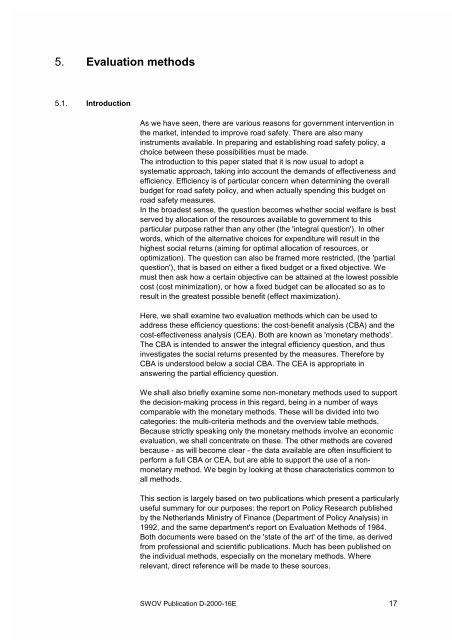Economic evaluation of road safety measures - Swov
Economic evaluation of road safety measures - Swov
Economic evaluation of road safety measures - Swov
You also want an ePaper? Increase the reach of your titles
YUMPU automatically turns print PDFs into web optimized ePapers that Google loves.
5. Evaluation methods<br />
5.1. Introduction<br />
As we have seen, there are various reasons for government intervention in<br />
the market, intended to improve <strong>road</strong> <strong>safety</strong>. There are also many<br />
instruments available. In preparing and establishing <strong>road</strong> <strong>safety</strong> policy, a<br />
choice between these possibilities must be made.<br />
The introduction to this paper stated that it is now usual to adopt a<br />
systematic approach, taking into account the demands <strong>of</strong> effectiveness and<br />
efficiency. Efficiency is <strong>of</strong> particular concern when determining the overall<br />
budget for <strong>road</strong> <strong>safety</strong> policy, and when actually spending this budget on<br />
<strong>road</strong> <strong>safety</strong> <strong>measures</strong>.<br />
In the b<strong>road</strong>est sense, the question becomes whether social welfare is best<br />
served by allocation <strong>of</strong> the resources available to government to this<br />
particular purpose rather than any other (the 'integral question'). In other<br />
words, which <strong>of</strong> the alternative choices for expenditure will result in the<br />
highest social returns (aiming for optimal allocation <strong>of</strong> resources, or<br />
optimization). The question can also be framed more restricted, (the 'partial<br />
question'), that is based on either a fixed budget or a fixed objective. We<br />
must then ask how a certain objective can be attained at the lowest possible<br />
cost (cost minimization), or how a fixed budget can be allocated so as to<br />
result in the greatest possible benefit (effect maximization).<br />
Here, we shall examine two <strong>evaluation</strong> methods which can be used to<br />
address these efficiency questions: the cost-benefit analysis (CBA) and the<br />
cost-effectiveness analysis (CEA). Both are known as 'monetary methods'.<br />
The CBA is intended to answer the integral efficiency question, and thus<br />
investigates the social returns presented by the <strong>measures</strong>. Therefore by<br />
CBA is understood below a social CBA. The CEA is appropriate in<br />
answering the partial efficiency question.<br />
We shall also briefly examine some non-monetary methods used to support<br />
the decision-making process in this regard, being in a number <strong>of</strong> ways<br />
comparable with the monetary methods. These will be divided into two<br />
categories: the multi-criteria methods and the overview table methods.<br />
Because strictly speaking only the monetary methods involve an economic<br />
<strong>evaluation</strong>, we shall concentrate on these. The other methods are covered<br />
because - as will become clear - the data available are <strong>of</strong>ten insufficient to<br />
perform a full CBA or CEA, but are able to support the use <strong>of</strong> a nonmonetary<br />
method. We begin by looking at those characteristics common to<br />
all methods.<br />
This section is largely based on two publications which present a particularly<br />
useful summary for our purposes: the report on Policy Research published<br />
by the Netherlands Ministry <strong>of</strong> Finance (Department <strong>of</strong> Policy Analysis) in<br />
1992, and the same department's report on Evaluation Methods <strong>of</strong> 1984.<br />
Both documents were based on the 'state <strong>of</strong> the art' <strong>of</strong> the time, as derived<br />
from pr<strong>of</strong>essional and scientific publications. Much has been published on<br />
the individual methods, especially on the monetary methods. Where<br />
relevant, direct reference will be made to these sources.<br />
SWOV Publication D-2000-16E 17
















